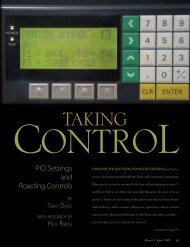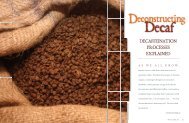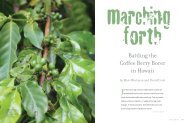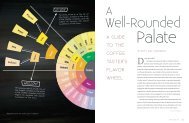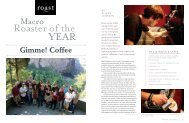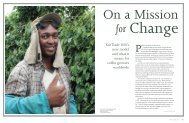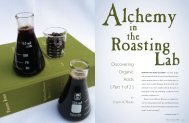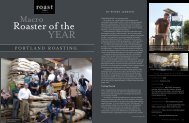You also want an ePaper? Increase the reach of your titles
YUMPU automatically turns print PDFs into web optimized ePapers that Google loves.
<strong><strong>Roast</strong>ing</strong><br />
<strong>Science</strong><br />
Looking Closely<br />
at Your Curves<br />
by Kathi Zollman<br />
We, as consumers, appreciate consistency.<br />
We like knowing that when we step to the counter and order a<br />
double scoop of mocha almond fudge ice cream on a sugar cone,<br />
we will be rewarded with the same deliciously cold, creamy<br />
treat we know and love—there are no surprises, and we’re never<br />
disappointed. Our heightened anticipation is matched with the<br />
consistent flavor from the first taste to the last, and we celebrate the<br />
experience. With this in mind, why is it that when we step up to the<br />
cupping table and begin the day’s sipping and slurping, the coffee<br />
we loved last week tastes dramatically different this week—not even<br />
coming close to meeting our expectations of flavor and delight?<br />
continued on page 52<br />
50 roast May | June 2012 51
<strong><strong>Roast</strong>ing</strong> <strong>Science</strong> | Looking Closely at Your Curves (continued)<br />
To satisfy our curiosity about this altered flavor, we must go to<br />
the source of the difference, pinpointing the cause and correcting the<br />
variance to retrieve the much-appreciated flavor. This is a big task,<br />
but when armed with the right tools, roasters of all sizes can easily<br />
integrate a few key steps into a quality-assurance program. Diligence<br />
in record-keeping and best roasting practices can assure that our<br />
favorite Yirgacheffe is predictably bright and sweet with a twist of<br />
lemon every time it drops out of the roaster.<br />
The first step in understanding the dramatic differences in a<br />
coffee is to cup it. That may sound like a no-brainer, but many roasters<br />
never cup their coffees, or they may not cup consistently. Cupping<br />
plays a significant part in quality assurance and building consistency<br />
of product, providing information to the roaster about each nuance<br />
the coffee brings to the cup. This is especially true when the coffee<br />
is roasted to the same color, but the roast profile experienced some<br />
variance in the path from start to finish. A visual inspection reveals<br />
that all is well with the roast; look for even roast color, full bean<br />
development and no hot spots on the bean. In most cases, a cupping<br />
evaluation is the only way to identify a problem before the coffee<br />
leaves the roastery. Or, even better, routine cupping can identify the<br />
best roasting results ever. If a coffee if roasted to perfection, having<br />
documentation of how it happened is even more important.<br />
Cupping can be a quick evaluation of the flavor character; roasters<br />
can create a cupping form that best suits their needs to record their<br />
Sample Cupping Notecard<br />
Carefully comment on the cup character as follows:<br />
Fragrance and aroma—Describe the smell of the ground<br />
coffee, both dry and wet. Some roasting taints can be found in the<br />
aroma and then confirmed when the coffee is slurped. Floral, spicy,<br />
sugary, medicinal, burnt, vanilla, meaty or fishy can describe the<br />
fragrance and aroma.<br />
Acidity —Find words to describe the type of acidity in the sample<br />
as well as the degree of acidity. Is there a bright sparkle or harsh<br />
bite? Also note if the coffee is flat with a lack of sparkle. Describe the<br />
acidity as clearly as possible.<br />
Body—How does the coffee feel: thick, buttery, heavy, thin, light or<br />
watery? There are times when the acidity is so harsh that the body of<br />
a coffee can be masked.<br />
Flavor—What does the coffee taste like? Is it perfect, or is there<br />
room for improvement? Does the overall flavor meet expectations?<br />
Good or bad, make easily understood notes.<br />
cupping notes. Complete and thoughtful cupping notes will make it<br />
easier to find a problem if one should arise later, but cupping notes can<br />
be as simple as a pass/fail system. Although cupping protocols may<br />
vary, it is important that roasters implement a protocol that suits their<br />
needs and carefully follow the protocol during each and every cupping<br />
session to ensure integrity of the process.<br />
After reviewing the cupping notes, we next look deeper to see<br />
where the roast profile varied. <strong>Roast</strong>ers rely on records of past roasts<br />
to track many things. A well-developed roast log provides data for<br />
quality control, product development, and cost controls and can even<br />
help track down a problem with a specific roast. <strong>Roast</strong> logs can be<br />
efficiently completed by hand, by charting time and temperature<br />
along with other variables, or roasters can install software to assist<br />
with the logging of each roast. These logs will provide the information<br />
to track down the changes in the roast profile that are causing the<br />
inconsistency in cup quality.<br />
Now, let’s look at the curves and technique applied by the roaster.<br />
By reviewing roast logs and making comparisons, it is likely that there<br />
is a variance in the curve. The slightest change in the roast profile—as<br />
little as five degrees on either side of the desired profile—can be evident<br />
in the cup. Too fast, too slow, too hot or too cold, each change will<br />
affect the resulting flavor of the roasted coffee, positively or negatively.<br />
Chemists have identified hundreds of compounds in a single coffee<br />
bean; most of these compounds are chemically altered during the<br />
roasting process. These alterations can produce a range of flavor<br />
variables. A quick review of the Specialty Coffee Association of America<br />
(SCAA) flavor wheel shows the colorful variety of flavors found in the<br />
roasted cup, most of which are developed during the roast process.<br />
Bright, fresh, fruity acidity; rich, creamy caramel; spicy, warm clove—<br />
these flavors are all there under the roaster’s control. The evil cousins<br />
to these same pleasurable results are flavors described as astringent<br />
medicinal, harsh bitterness, woody and burnt rubber.<br />
To illustrate the range of roasted flavors in a single coffee variety,<br />
several coffee roasters were asked to participate in a roaster challenge.<br />
This small army of roasting daredevils was asked to take their favorite<br />
roasted coffee and then perform two more roasts, intentionally risking<br />
the results. The roast profile was drastically altered to obtain the<br />
resulting changes. <strong>Roast</strong>ers were challenged to roast faster, slower<br />
and longer—breaking away from the preferred roast profile. These<br />
roasting facilities do not have access to scientific analytical equipment<br />
to measure the results of the roast variations, making this a very<br />
practical hands-on type of experiment. The results, however, were so<br />
obvious that an HPLC, or high-performance liquid chromatography,<br />
wasn’t required to identify the resulting chemical changes. (In a food<br />
lab setting, tools like the HPLC are used to separate the mixture for the<br />
purpose of identification and quantification of the components found<br />
in each of the liquid coffee samples.)<br />
continued on page 54<br />
52 roast May | June 2012 53
<strong><strong>Roast</strong>ing</strong> <strong>Science</strong> (continued)<br />
Simply cupping the coffees revealed both great and awful<br />
roasting results. Interestingly, when these profiles were repeated<br />
and cupped in a blind cupping, the cupping volunteers (consumers)<br />
were surprised to learn that there was only one coffee on the table.<br />
The differences in flavor, body and aftertaste were so dramatic that<br />
they assumed there were several coffees.<br />
Technique #1<br />
“I forgot to turn on the heat”<br />
This is a surprisingly common technique that occurs most often<br />
when roasters are distracted and forget to turn the heat on, or up,<br />
after the green coffee is dropped into the roaster. Phone calls and<br />
texting are a common cause for practicing this technique; the<br />
interruption of answering the phone takes the operator away from<br />
the task just long enough that the heat is forgotten. Then, about<br />
halfway through the roast time, full heat is applied, resulting in<br />
what is referred to as “catching up.” The coffee turns the correct<br />
color and reaches the final temperature in the right amount of<br />
time. The S-curve for this profile would appear flat in the first half<br />
of the roast with little increase in bean temperature, with a sharp<br />
climb in the second half of the roast. The point of equilibrium was<br />
150 degrees F; the slow start also produced a noticeably quiet first<br />
crack as a portion of the free moisture in the bean evaporates. The<br />
bean appeared to be well developed and had a slight oil sheen to it.<br />
Common cupping comments: Light fragrance/aroma, little to<br />
no sweetness, flat acidity and a chalky alkaline aftertaste.<br />
An exaggerated slow start to a roast with an extreme and<br />
aggressive finish did not produce a favorable cup result. When<br />
roasters experience a flat, chalky-tasting coffee, it could be linked<br />
to an extreme profile like the one experienced here.<br />
Technique #2<br />
“I have to roast a lot of coffee”<br />
Many roasters feel the need for speed. Time is indeed money for<br />
any roasting company, and the more batches that are produced per<br />
hour, the better. Or, in some cases, the faster the work is finished,<br />
the sooner the roaster can go home. The fast-roast exercise was<br />
completed by dropping the coffee into a hot roasting environment at<br />
full heat. The application of full heat pushed the roast to completion<br />
in half the time of the control roast profile. The roasted coffee was<br />
dropped at the same temperature and looked pretty much the same<br />
as the other test roasts. A closer visual inspection revealed several<br />
scorch marks and some blowout marks from the extreme-heat<br />
environment.<br />
The cupping results did not bode well for the hot-and-fast<br />
roast technique. The aromatics were pleasant and berry-like, more<br />
apparent than in Technique No. 1, but the attributes were less<br />
flattering as the cupping proceeded for this sample. One cupper<br />
experienced a severe case of “bitter beer face” after the first slurp,<br />
not expecting the cup to be so astringent and medicinal. The cup<br />
produced no sweetness, with harsh acidity, herbal flavor, very light<br />
body and a lasting aftertaste of dirt.<br />
The fast roast produced an undeveloped-tasting coffee, making<br />
it difficult to identify what coffee was in the cup. The sweet<br />
caramel notes did not appear, and the fruit acids were masked by<br />
the harshness. Though production is nearly doubled using this<br />
technique, the coffee was very bitter and unpleasant.<br />
Technique #2 <strong><strong>Roast</strong>ing</strong> Curve<br />
Time vs. Temperature<br />
Technique #1 <strong><strong>Roast</strong>ing</strong> Curve<br />
Time vs. Temperature<br />
500°F<br />
Degrees<br />
500°F<br />
400°F<br />
400<br />
Degrees<br />
400°F<br />
400<br />
300°F 300<br />
300°F 300<br />
200°F<br />
200°F<br />
100°F<br />
100°F<br />
0°F 0<br />
0 1 2 3 4 5 6 7<br />
0°F 0<br />
0 1 2 3 4 5 6 7 8 9 10 11 12 13<br />
Time in Minutes<br />
Time in Minutes<br />
continued on page 56<br />
54 roast May | June 2012 55
<strong><strong>Roast</strong>ing</strong> <strong>Science</strong> (continued)<br />
Technique #3<br />
“My roaster is too hot”<br />
Technique #4<br />
“Can it get any worse?”<br />
This roast technique involves a highly heated drum combined with<br />
With this technique, the roasters were challenged to roast out<br />
minimal heat application to slow the roast down, which makes<br />
everything good about the coffee. Can a roaster take a remarkable<br />
the roast appear to be controlled. This technique employed high<br />
sweet and bright coffee and turn it into something that even the<br />
initial heat with a point of equilibrium of nearly 250 degrees F and<br />
most skilled cupper can’t recognize? The answer is simple: Yes. This<br />
low heat application to prevent the coffee from gaining momentum<br />
technique starts out very hot, and then all heat is pulled as the beans<br />
and roasting too quickly. The heat was maintained at about 50<br />
dance around in the roaster. There is enough residual heat to keep<br />
percent until first crack was reached; at this time, maximum heat<br />
the roast moving forward and not stalling out. One-third of the way<br />
was required to hit the desired time and final temperature of the<br />
into the roast time frame, the heat is introduced at 50 percent; a very<br />
roast profile. First crack was light with minimal noise. As with the<br />
dull first crack follows. Then at two-thirds time, full heat is applied<br />
previous two techniques, the coffee looked fine, with no reason to<br />
to bring the roast in on time. The roast finished at the right time<br />
assume otherwise. The profile has a bit of an S-curve to it, and the<br />
and the correct temperature. Good news for the roaster: the roast log<br />
prescribed time and temperature were reached.<br />
looks great, the coffee has a dull look to it but otherwise looks okay—<br />
Cuppers’ notes included a range of descriptions for this<br />
not too bad at all. The proof will be in the cupping. The S-curve looks<br />
technique. Aromatics included marshmallow and toasted nuts,<br />
slightly like a stair-step.<br />
even warm brown sugar. Other notes: a hint of sweetness,<br />
Cuppers’ comments were not positive for this technique; the<br />
bittersweet chocolate, moderate acidity, slightly skunky by one<br />
notes were blunt and pulled no punches. The aroma of the coffee<br />
cupper, aftertaste was lingering and slightly ashy. The body of this<br />
was compared to burnt peat moss, compost and bitter dirt. After the<br />
coffee was considered moderate rather than light, as in the first<br />
break, one cupper noted a hint of roasted peanuts. No sweetness<br />
two techniques.<br />
was found, flavor was nutty and slight. No acidity; the coffee was<br />
This was not a perfect cup as evaluated by the panel, but<br />
scored as flat, all sparkle was roasted out. Aftertaste was lingering<br />
this technique did develop some of the sweeter characteristics of<br />
compost, and body was described as watery by all cuppers.<br />
caramel and chocolate of the Maillard reaction. There was some<br />
This radical S-curve technique brought out the worst in this<br />
improvement over the other samples, but it was still difficult to<br />
coffee, taking a very respectable sweet, bright and hard bean and<br />
identify the coffee in the cup and even more difficult for the panel<br />
transforming it into brown water that wasn’t palatable. Yes, it really<br />
to accept that this was the very same coffee cupped in the previous<br />
was that awful. This technique produced undesirable results and<br />
round.<br />
should be avoided.<br />
Technique #3 <strong><strong>Roast</strong>ing</strong> Curve<br />
Time vs. Temperature<br />
Technique #4 <strong><strong>Roast</strong>ing</strong> Curve<br />
Time vs. Temperature<br />
500°F<br />
Degrees<br />
500°F<br />
Degrees<br />
400°F<br />
400<br />
400°F<br />
400<br />
300°F 300<br />
300°F 300<br />
200°F<br />
200°F<br />
100°F<br />
100°F<br />
0°F 0<br />
0 1 2 3 4 5 6 7 8 9 10 11 12 13 14 15 16<br />
Time in Minutes<br />
0°F 0<br />
0 1 2 3 4 5 6 7 8 9 10 11 12 13 14<br />
Time in Minutes<br />
continued on page 58<br />
56 roast May | June 2012 57
<strong><strong>Roast</strong>ing</strong> <strong>Science</strong> | Looking Closely at Your Curves (continued)<br />
<strong><strong>Roast</strong>ing</strong>, or the application of energy,<br />
is what changes green coffee from a plainlooking,<br />
slightly fragrant bean to a desirable,<br />
complex, aromatic bean. The flavors are<br />
waiting to be developed and experienced.<br />
The changes the coffee goes through during<br />
roasting are both physical and chemical<br />
in nature. These changes are complex and<br />
occur at different stages along the roast path.<br />
Beyond the obvious color change from green<br />
to rich brown, other physical changes are<br />
observed. Most roasters have experienced<br />
first crack, occurring at around 385 degrees<br />
F; here, the coffee pops, sounding similarly<br />
to popcorn, and the coffee nearly doubles<br />
in volume in this phase. Other chemical<br />
changes are increasingly complex and<br />
occur within the bean. Optimum roasting<br />
conditions for these changes result in the<br />
formation of desirable coffee attributes.<br />
Changes occurring during the roast<br />
are extremely complex and require a food<br />
chemist’s knowledge to decipher. A very<br />
simplified model would identify the major<br />
changes as follows:<br />
Loss of water content—Green coffee has<br />
a moisture content of 10 to 12 percent; water<br />
is lost in the early stage of the roast, in the<br />
Maillard reaction, and finally during the<br />
Managing roasting techniques and<br />
practicing cupping as a part of a qualityassurance<br />
program will assure the<br />
consistency we all appreciate and eliminate<br />
most of the surprises. An untested coffee<br />
shouldn’t leave the roastery if there is even<br />
the slightest chance that it could vary from<br />
the best profile. If the favorite Yirgacheffe<br />
coffee from last week is not the same<br />
lemon-sweet, sparkling coffee this week,<br />
chance. Take time to control the outcome with<br />
proven roasting techniques for each coffee and<br />
be accountable to the practices. The cupping<br />
table results will support the sound roasting<br />
practices, and you can be confident that when<br />
your customers place an order for their favorite<br />
coffee, the beans will meet or exceed their<br />
expectations.<br />
Kathi Zollman, assistant director of<br />
specialty green coffee sales at Coffee Holding Company,<br />
is a frequent presenter at a variety of roaster education<br />
venues. She has shared coffee-roasting skills at <strong>Roast</strong>ers<br />
Guild events, the annual SCAA Conference, Coffee Fest<br />
and multiple regional roaster gatherings. Specializing<br />
in blending, sensory skill-building, and profile roasting<br />
and manipulation, she continues to be a student of all<br />
things coffee.<br />
dry distillation phase of the roast.<br />
a quick review of the roast log will help<br />
Loss of weight—The darker the roast, the<br />
higher the loss of dry mass, ranging from 10<br />
percent in medium roasts to near 20 percent<br />
in darker roasts.<br />
isolate the potential problem. Too much<br />
heat, too large of a batch size, not enough<br />
heat—there are so many ways for trouble to<br />
brew.<br />
<strong>Roast</strong>ers need to become experts at<br />
Decomposition of chlorogenic acids—<br />
Nearly 10 percent of the coffee bean’s<br />
weight is made up of chlorogenic acids, a<br />
bitter tasting group of acids. When chlorogenic<br />
acids break down during roasting,<br />
two byproducts are quinic acid and caffeic<br />
cause and effect; if something negative<br />
is happening, what can be the cause (or<br />
causes)? Use the extreme roast techniques<br />
illustrated here as a reference point for<br />
corrective changes to the roast profile. For<br />
example:<br />
acid, both known for bitter and astringent<br />
qualities. The entire CGA group is susceptible<br />
to change during roasting; 50 percent<br />
of the CGAs are destroyed and 80 percent are<br />
decomposed by the dark roast profile.<br />
Reconfiguration of sucrose—Nearly all<br />
the simple sugars are lost during the roast<br />
process, resulting in water and carbon dioxide,<br />
and flavor, aroma and color in the Mail-<br />
If the coffee tastes flat, not quite as<br />
bright as you remembered it being, look at<br />
the first portion of the roast. If the curve<br />
is flat with little temperature increase<br />
before it starts to climb, the acidity could be<br />
flattened out and the bright sparkle will be<br />
lost. Some loss of aromatics might also be<br />
noted in this scenario.<br />
lard reaction.<br />
If the sweet coffee has lost its sweetness<br />
Decreased concentrations of amino acids<br />
and proteins—Proteins, amino acids and<br />
sugar combine in the Maillard reaction,<br />
resulting in some of the most enjoyable<br />
aromas and flavors found in roasted coffee.<br />
Caramel and chocolate flavors are consid-<br />
and tastes bitter and harsh, look at the<br />
point of equilibrium and the application<br />
of heat. These characteristics can be<br />
associated with too much heat too soon and<br />
too fast of a roast. These beans might also<br />
appear to be unevenly roasted.<br />
ered to be a result of the Maillard reaction.<br />
The four roasting techniques described<br />
Simplified, yes, but the basic premise is<br />
achieved. With the hundreds of compounds<br />
developed during coffee roasting, there are<br />
also a few compounds that remain stable<br />
and unchanged. Lipids, salts, caffeine and<br />
a group of carbohydrates escape change in<br />
roasting. There is plenty of room for error,<br />
but also room for great success for coffeeroasting<br />
enthusiasts wanting to take the<br />
rather bland green bean and roast it to<br />
something wonderful, unlocking all the<br />
secret flavors and textures hidden within<br />
the walls of the bean.<br />
are exaggerated but also very real, with<br />
each one taken from an actual roasting<br />
situation. Taking roasting shortcuts<br />
typically results in a variation in the final<br />
product, even when it visually appears to be<br />
identical.<br />
Consistency in product is essential<br />
to customer satisfaction and retention,<br />
wholesale or retail. Creating a consistent<br />
product requires record keeping and a<br />
quality-control protocol that becomes the<br />
rule, not the exception. There are literally<br />
hundreds of opportunities for the coffee to<br />
be amazing, so roasters shouldn’t leave it to<br />
58 roast May | June 2012 59



